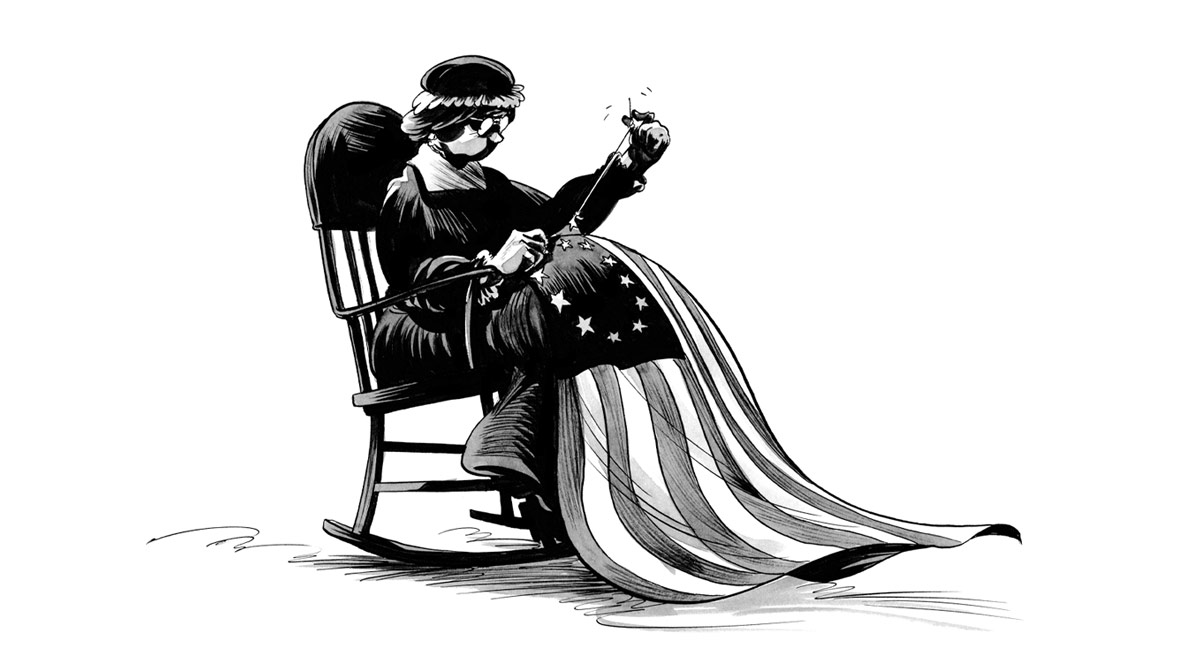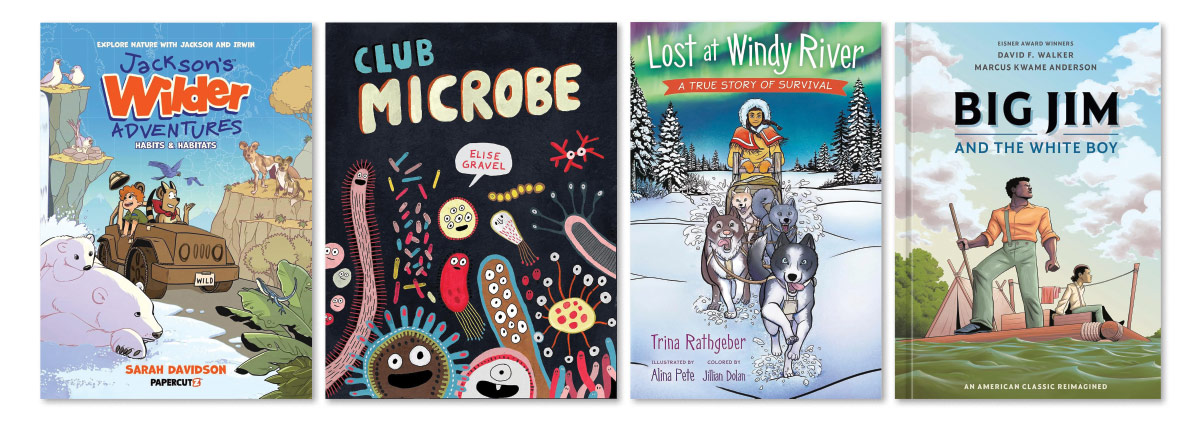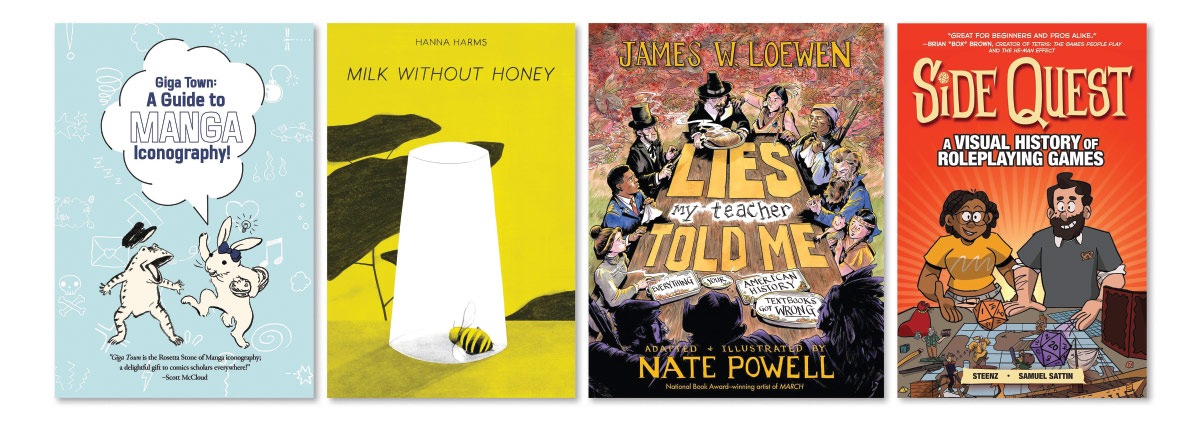Keeping It Real: Eight Standout Nonfiction Graphic Novels | Stellar Panels
In these recent releases, text and visuals complement each other to explain complicated concepts such as historical battles and biological cycles.
 |
Lies My Teacher Told Me (Loewen) ©2024 by Nate PowellCourtesy of The New Press |
 Nonfiction graphic novels are growing in number and appeal. The combination of text and visuals lends itself well to explaining complicated concepts such as historical battles and biological cycles. And unlike textbooks and reference books, graphic novels add a narrative element, either embedding the facts in a story or having a character speak directly to the reader.
Nonfiction graphic novels are growing in number and appeal. The combination of text and visuals lends itself well to explaining complicated concepts such as historical battles and biological cycles. And unlike textbooks and reference books, graphic novels add a narrative element, either embedding the facts in a story or having a character speak directly to the reader.
While still a small category compared to fiction, there are many standout nonfiction graphic novels, appealing to a wide variety of reader interests. Series such as “History Comics” and “Science Comics” from First Second, “I Survived” from Graphix, “Nathan Hale’s Hazardous Tales” from Amulet, and “Giggle and Learn” from TOON Books, are stalwarts of the field. But many one-off nonfiction works are worth a closer look as well.
Each of these eight recent and forthcoming graphic novels provides a broad overview of a topic, drills down into the specifics of an area, or offers a new perspective on familiar material. None is a substitute for what goes on in classroom teaching, but all are engaging and offer a novel take on the topics at hand.

DAVIDSON, Sarah. Jackson’s Wilder Adventures, Vol. 1. illus. by author. Papercutz. Jul. 2024.
Gr 1-5–This chapter book, the first in a series, stars young Jackson Wilder and his stuffed Thylacine, Irwin, who has a Hobbes-like ability to come alive when no adults are in the room. Irwin can also transport the two of them to different parts of the world. Together they explore two concepts: animals that eat gross things and animals whose habitats are shrinking. Irwin presents the information clearly and in an interesting way, with lots of little surprises. The Arctic tern, for instance, eats slugs and then regurgitates them to feed her chicks. While Jackson is grossed out by this, Irwin explains that the mother must travel so far to find food that it’s easiest for her to carry it in her stomach—and besides, baby terns, like baby humans, can’t eat solid food. The stories are short, and each one ends with a puzzle, such as a maze or spot-the-differences pictures, involving the animal that was just discussed. The title is pitched at a younger audience and will appeal to fans of series such as First Second’s “Science Comics” and Capstone’s “Max Axiom” graphic novels.
GRAVEL, Elise. Club Microbe. tr. by Montana Kane. illus. by author. Drawn & Quarterly. Apr. 2024.
Gr 1-3–As in her previous books, including The Bug Club , Gravel approaches her subject with enthusiasm and humor, giving readers a basic introduction to the types of microbes, where they can be found, and what they do, as well as some examples of the most interesting ones and fun facts (e.g., if all the microbes in your body were put in one place, they would weigh as much as a brick!). Gravel’s cute, anthropomorphized microbes include bacteria that create farts, bacteria that form the nuclei of snowflakes, and viruses that eat bacteria. The book includes some health
reminders about hand-washing, vaccination, and foods that are good for our gut bacteria. The art is simple and appealing, with just a few elements per page, so it is never overwhelming. Gravel’s combination of basic information and interesting facts, delivered with a dollop of whimsy, makes this an ideal book for early readers.
RATHGEBER, Trina. Lost at Windy River: A True Story of Survival. illus. by Alina Pete. Orca. Oct. 2024.
Gr 3-8–In 1944, young Cree girl Ilse Schweder got lost in a snowstorm in the unforgiving landscape of northern Canada and survived for nine days before being rescued. Farley Mowat told the story in his book People of the Deer, but Rathgeber, Ilse’s granddaughter, reclaims it in this graphic novel, saying that Ilse “always felt strongly that it was her story to tell, not his.” Although Ilse did not live to see the final book published, she worked with Rathgeber on the text, and the story not only centers Ilse’s experience, but also includes numerous details of Cree lore and life that Mowat did not know. Pete’s artwork is straightforward and easy to follow, with luminous depictions of the landscape and animals of the far north. Colorist Jillian Dolan makes excellent use of different palettes to ground each sequence. The book includes footnotes on Cree culture, photos of Ilse and her family, and an afterword in which Rathgeber explains how the story came to be.
WALKER, David F. Big Jim and the White Boy: An American Classic Reimagined. illus. by Marcus Kwame Anderson. Ten Speed Graphic. Oct. 2024.
Gr 7-9– OK, Huckleberry Finn is not nonfiction, but it is a book that almost everyone reads in high school, and this graphic novel offers plenty of food for thought. Walker and Anderson take the lead characters and some of the plot elements of Mark Twain’s classic novel and weave a new story told from the point of view of Jim, who is not only fleeing slavery but also searching for his kidnapped wife and children. Huck is his companion, a necessity in the antebellum South, and while Jim is the smarter and more mature of the two, Huck often has to appear to take charge while Jim plays dumb. The storytelling is complex, with multiple flashbacks and a sort of double framing structure in which an elderly Jim and Huck tell the story to Jim’s grandchildren, bickering about the details, while Jim’s great-granddaughter, an academic living in the present day, adds commentary based on both her scholarship and her grandmother’s memories of hearing the story. Nonetheless, the book is an action-packed page-turner, with dastardly villains, narrow escapes, and a twist at the end that sheds a new light on the entire story. Anderson’s art has a cinematic quality, rendering the action sequences with dramatic lighting and thoughtful paneling that make them easy to follow and depicting the characters with simple lines that nonetheless convey nuances of thought and emotion. In a foreword, Walker explains his decision to include the N-word, in order to be true to the period; the back matter includes historical notes and a bibliography.

KOUNO, Fumiyo. Giga Town: A Guide to Manga Iconography! illus. by author. Udon. Sep 2024.
Gr 8 Up–Anthropomorphized rabbits, frogs, and other animals demonstrate over 100 symbols, gestures, and facial expressions commonly used in manga in this charming volume. Each page includes an explanation of one component of manga iconography (manpu) and a short comic that demonstrates its use, featuring characters based on Chōjū-jinbutsu-giga, caricatures of animals and people found on illustrated scrolls created almost 1,000 years ago by Japanese monks. A foreword by manga scholar Matt Alt provides historical context and an introduction to what follows. Short notes accompanying some of the comics explain cultural references that may be unfamiliar to non-Japanese readers. Kouno, creator of the historical manga Town of Evening Calm, Country of Cherry Blossoms, and In This Corner of the World , has a deft, gestural style that evokes traditional Japanese brush painting.
HARMS, Hanna. Milk Without Honey. illus. by author. Street Noise. Sept. 2024.
Gr 8 Up–This quiet book uses simple text and delicate drawings, some realistic and some abstract, to explain why bees are important, why they are in danger, and why saving them is not a simple matter at all. Harms uses a limited palette and distributes the images and text carefully across each page, creating a book that often reads like poetry and sometimes packs an emotional punch while also conveying a lot of factual information about the lives of bees, their interdependence with humans, and the predators and other threats they face. It’s a deceptively simple book that leaves readers both moved and hungry for more, and Harms winds it up nicely with an afterword by bee expert Jürgen Tautz that sums the book’s premise up and offers some next steps, as well as a bibliography and list of web resources.
LOEWEN, James W. & Nate Powell. Lies My Teacher Told Me. illus. by Nate Powell. New Pr. Apr. 2024.
Gr 8 Up–“They don’t want you to know this” is catnip to teenagers (and adults, for that matter), and this book serves up a whole lot of that with a captivating narrative filled with concrete examples of historical figures and events that standard textbooks either ignore or distort. Loewen’s 2019 release, Lies My Teacher Told Me: Everything Your American History Textbook Got Wrong , is already a provocative book that many high school students would find interesting, and in this adaptation, Powell uses sophisticated graphic storytelling to bring the words to life, as he did in the award-winning “March” trilogy by the late congressman John Lewis. The result is a fascinating retelling of American history that takes a critical look at the standard narratives, both specific and general, and shows how the misperception of the past affects the present. While this graphic novel is, of necessity, text-heavy, Powell breaks it up and brings in plenty of visuals to keep readers engaged, avoiding the pictures-with-captions trap that many nonfiction graphic novels fall into. The book ends with a look at why textbooks are so bad and what students and teachers can do about it, as well as a call to educators to change the way history is taught, and to students to ask questions, do research, and call out the lies and misinformation they find. It’s both fascinating and empowering, filled with “I didn’t know that!” moments that spur readers to continue learning and researching on their own.
SATTIN, Samuel. Side Quest: A Visual History of Roleplaying Games. illus. by Steenz. Versify. Oct. 2024.
Gr 8 Up–Sattin and Steenz, appearing as themselves, take readers on a guided tour of the history of tabletop roleplaying games, from the board games of ancient times through the war games of the 18th and 19th centuries to modern-day TTRPGs and LARPing. There are plenty of side quests as well, as they discuss their own experiences and the psychological aspects of RPGs. Sometimes they go farther afield: the section on war games includes a discussion between the young Sattin and his grandfather, a World War II veteran, about the realities of the battlefield. Both authors take a lively, irreverent approach to the topic, and Steenz, who draws and writes the “Heart in the City” comic strip, has a loose, cartoony style that works well with the narrative. The book concludes with a glossary, an extensive bibliography, and an original RPG based on Dungeons & Dragons: 5th Edition.

Add Comment :-
RELATED
The job outlook in 2030: Librarians will be in demand
The job outlook in 2030: Librarians will be in demand
ALREADY A SUBSCRIBER? LOG IN
We are currently offering this content for free. Sign up now to activate your personal profile, where you can save articles for future viewing





